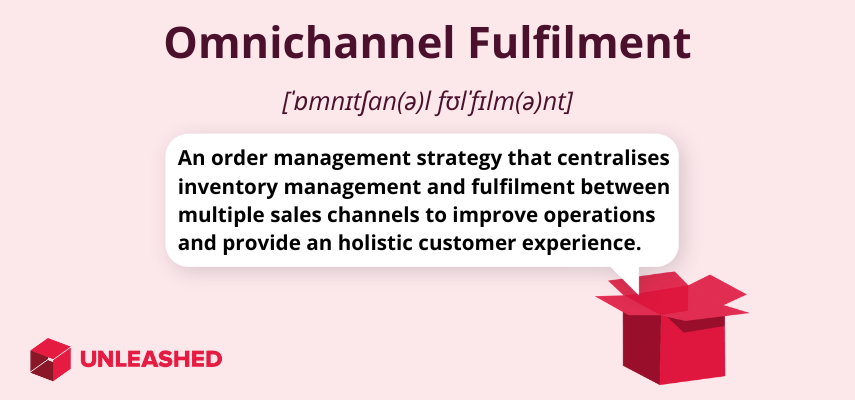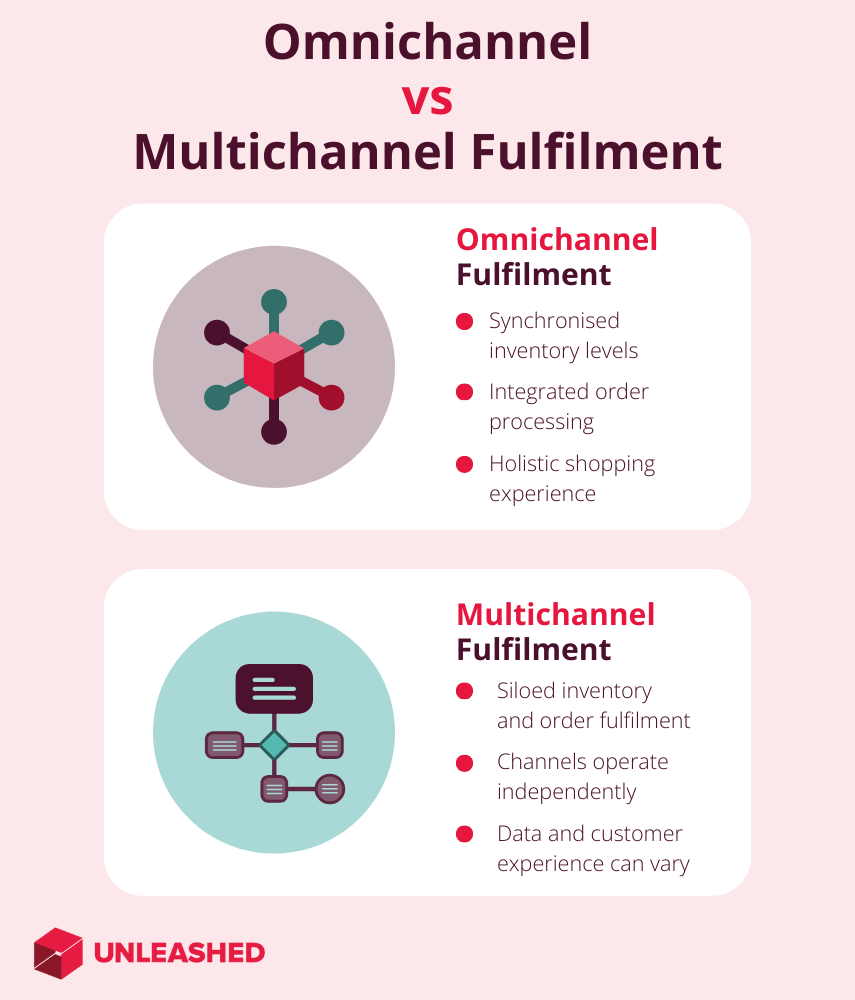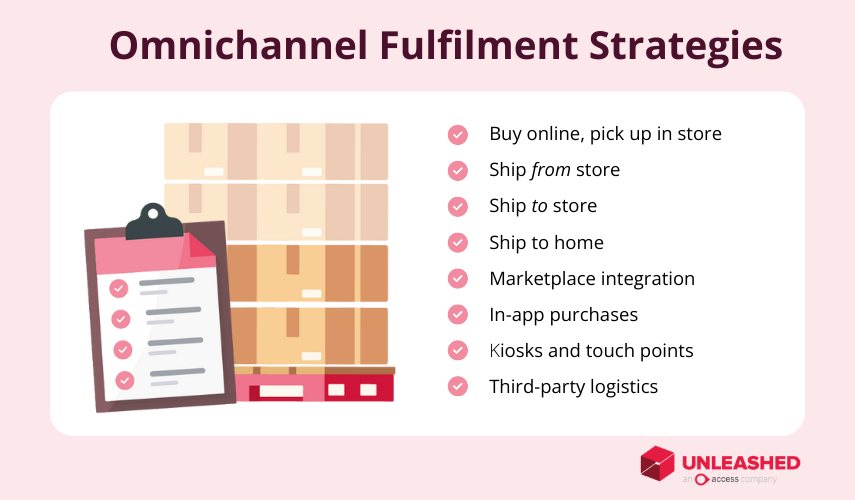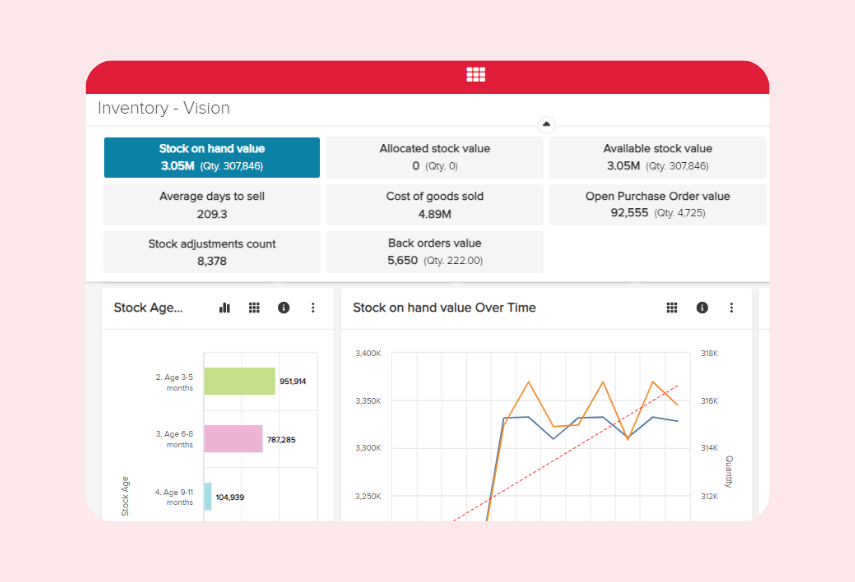
Ecommerce, brick and mortar, social apps, wholesale... The number of ways to sell products grows by the day.
To master all these channels, you need a strategy that ties them together. Enter: omnichannel fulfilment.
Omnichannel fulfilment provides a seamless and consistent customer experience for shoppers. It also allows you, the merchant, to cut down on admin and grow your sales. This article explores what omnichannel fulfilment is and how it helps ecommerce stores and retailers be more efficient. We'll also cover a few best practices for perfecting your omnichannel strategy.

What is omnichannel fulfilment?
Omnichannel fulfilment is an order management strategy that centralises inventory management and order fulfilment between multiple selling channels for the purpose of creating an holistic, streamlined customer experience.
The omnichannel fulfilment process aligns order fulfilment operations between different channels by synchronising tasks such as order picking, packing, receiving, and returns management. It involves integrating physical and digital touchpoints, such as brick-and-mortar stores, websites, mobile apps, and social media.
The goal is to connect these platforms in a way that allows customers to interact, browse, purchase, and receive products or services through a sales process that feels unified and cohesive.
A study by Salesforce recently found that 75% of consumers expect consistent experiences across multiple channels. Omnichannel fulfilment aims to enhance customer satisfaction, loyalty, and convenience by giving them the flexibility to engage with a brand and business in the way that suits them best – whether that's online, in-person, or a combination of both.
Multichannel vs omnichannel fulfilment
Multichannel and omnichannel fulfilment both refer to a strategy whereby a company sells its goods through multiple channels. The main difference lies in how they approach the integration of various sales channels.
While the multichannel fulfilment method uses separate inventory control and order fulfilment workflows for each channel, omnichannel brings everything together – including customer service and distribution.
Key aspects of an omnichannel strategy:
-
Retailers employ technology and systems that synchronise inventory levels, order processing, and customer data across all channels.
-
It enables customers to freely switch between sales channels without encountering issues in their shopping journey.
-
It prioritises the customer's convenience and aims to create a holistic brand experience.
Key aspects of a multichannel strategy:
-
Products and services are sold through multiple channels that operate independently – there may not be a seamless flow of information between them.
-
Customers can have different experiences when switching between channels.
-
It focuses on expanding the reach of the brand through various sales outlets more than providing a completely unified experience.
The main distinction is that omnichannel places a strong emphasis on customer-centricity, whereas multichannel fulfilment involves operating through multiple channels that may or may not be integrated.

How omnichannel order fulfilment works
Omnichannel order fulfilment works by integrating various sales channels so customers can shop where they want, when they want, and still receive the same experience. Retailers and ecommerce merchants can then manage those customer orders using an integrated fulfilment workflow.
The process for managing omnichannel orders will vary from business to business, but we can break it down into several key stages you'll find in a typical omnichannel model.
Multiple sales channels
A company selling goods makes their products available on multiple sales channels. For example, Facebook Marketplace, Google Shopping, and a physical retail shop. Information and brand experience are unified across each channel to create a seamless sales experience that meets modern-day consumer expectations.
Inventory management
An integrated inventory tracking system is used to manage all available products across different channels. This ensures that accurate and up-to-date inventory information is accessible to both customers and the business. Inventory for all stores is typically kept in a shared location (or locations) which is often managed using a central warehouse management system.
Order processing
When a customer places an order – whether in your ecommerce store, your retail outlet, or through another channel – the information is relayed to the central system. Because inventory is synced across the company, there is no risk of processing an order that cannot be fulfilled because the items were already sold elsewhere.
Fulfilment options
Customer orders are fulfilled from the same place, regardless of sales channel. Customers are given options on how receive their goods: home delivery, in-store pickup, or any other available fulfilment methods. The system ensures that each option is viable and efficient based on inventory availability, supply chain integration, and customer preferences.
Customer satisfaction
To match consumer expectations, customers receive a consistent experience no matter where they interact with the brand. It doesn't matter if they browse the company's website and social media profile before shopping in-store; they see the same products, prices, and promotions – and their preferences are remembered across channels.
Once they've made a purchase, the customer is provided with real-time updates regarding their order status. If they need to return or exchange a product, the process is streamlined across all channels.
Analytics and insights
The retailer's system gathers data from all channels, allowing the business to analyse customer behaviour, preferences, and trends holistically. This information can be used to make informed decisions about inventory management, purchasing, marketing, and customer engagement tactics.
Omnichannel fulfilment example
Sarah is browsing Instagram when a clothing retailer she follows has a post about new winter stock that’s arrived. She clicks on an item she likes and is taken straight through to the jacket’s product page on the retailer’s website. She decides to purchase it online.
Sarah selects the option ‘buy online, pick up in store’, so she can pick it up that afternoon and save on shipping fees.
For the retailer, the system will immediately update its inventory database to reflect that one jacket has been sold to Sarah. The system will then notify Sarah’s nominated store and an employee will prepare the jacket for collection.
Once this is completed, Sarah receives an email confirming her order is ready to be picked up. 47% of shoppers will purchase additional products inside the store when collecting an item ordered online. When it’s convenient, Sarah goes to the store to collect her jacket and ends up purchasing three more items in-store while she's there.
In this example, omnichannel fulfilment integrates online and in-store shopping. It demonstrates how omnichannel strategies can lead to increased customer engagement and sales: Sarah starts her shopping journey on her phone, enjoys a hassle-free pick up in-store, and ends up spending even more once she gets there.
8 types of omnichannel fulfilment strategy
Next, let's look at some common types of omnichannel fulfilment strategies. These can be used individually or in combination, depending on the specific needs and preferences of the retailer and the customers they serve.

8 popular omnichannel fulfilment strategies:
-
1. Buy online, pick up in store (BOPIS) – Customers can make purchases online and then pick up their items from a physical store location. This allows for a convenient and quick way to get products without waiting for shipping.
-
2. Ship from store – Retailers use their physical stores as distribution centres. When an online order is placed, it can be fulfilled and shipped directly from a nearby store rather than a centralised warehouse.
-
3. Ship to store – Customers can choose to have their online orders shipped to a specific physical store for pickup. This provides flexibility for customers who may not be available for home delivery.
-
4. Ship to home – The traditional e-commerce model, whereby products are shipped directly to the customer's home from a centralised distribution centre or individual stores.
-
5. Marketplace integration – Retailers can expand their reach by integrating with third-party marketplaces. This allows customers to discover and purchase products through platforms like Amazon or eBay while still receiving a unified brand experience.
-
6. In-app purchases – Retailers create their own mobile apps that facilitate purchases. Customers can browse and buy products directly within the app, providing a seamless and brand-specific shopping experience.
-
7. Interactive kiosks and touchpoints – Interactive kiosks or touchpoints on websites and mobile apps enhance the customer experience by offering additional information, recommendations, and options for purchasing.
-
8. Third-party logistics – Businesses leverage the expertise and capabilities of a third-party supplier to handle omnichannel order fulfilment, freeing up retailers and ecommerce operators to focus on their core capabilities.
Once you've decided on the approach(es) that will most benefit your company, use these next tips to fully optimise the shopping experience across your physical and online sales channels.
Omnichannel fulfilment best practices
Despite supply chain disruptions over recent years, almost two-thirds of consumers globally expect that the products they order online will be delivered within two days of ordering.
Getting your omnichannel strategy right will not only improve your operational efficiency – it will help you meet the expectations of your end customer.
Here are some best practices for effective omnichannel retailing:
-
Maintain a centralised system that accurately tracks product availability across all channels in real-time. This ensures customers receive accurate information about stock levels.
-
Provide a consistent shopping experience across all touchpoints, whether online or in-store. Ensure that branding, pricing, and product information are uniform.
-
Offer a variety of fulfilment methods like BOPIS, next-day delivery, and traditional shipping. This caters to different customer preferences and urgencies.
-
Equip all staff with correct knowledge and training, so no matter who a customer speaks to, they will receive the same service and information.
-
Leverage customer data to provide personalised experiences. This can include tailored product recommendations, special promotions, and targeted marketing.
-
Streamline your supply chain operations to ensure products are readily available and can be distributed efficiently across various channels.
-
Allow customers to keep informed about their orders with timely notifications, order status updates, and shipment tracking. Transparency builds confidence and reduces uncertainty.
-
Regularly monitor key performance indicators (KPIs) such as order accuracy, fulfilment speed, customer satisfaction, and channel effectiveness. Use data-driven insights to identify areas where improvements can be made.
-
Actively seek and listen to customer feedback to understand pain points and areas for improvement. Use this input to adapt and refine your omnichannel strategy.
By following these best practices, businesses can create an exceptional experience for customers to drive satisfaction, loyalty, and revenue growth.
Omnichannel fulfilment services
Omnichannel fulfilment services are available for companies that wish to outsource some or all of the order management process to a third-party provider. These service providers are typically third-party logistics companies that can take advantage of existing physical infrastructure to more efficiently fulfil customer orders.
To find omnichannel services in your area, speak to a business consultant or simply search "omnichannel fulfilment service" on Google.
Omnichannel fulfilment software
Omnichannel fulfilment software refers to digital tools that enable businesses to integrate customer data, stock control, and order management between multiple sales channels. There are specific systems available to tackle singular elements of the omnichannel process, as well as comprehensive tools that bring all of your business data and workflows under one roof.
Here's a quick breakdown of some useful types of omnichannel software and what they do.
 Here you can see how Unleashed software supports omnichannel fulfilment by syncing sales data between channels.
Here you can see how Unleashed software supports omnichannel fulfilment by syncing sales data between channels.
Inventory management software
Cloud-based inventory software allows businesses to track and manage their product inventory in real-time across all sales channels. It ensures accurate stock levels and prevents overselling, whether online or in store. Some inventory tools such as Unleashed Software (pictured above) also offer features for managing purchasing, order fulfilment, and production.
Order management software
Order management software creates a central location for all customer orders to be processed across different channels, including online stores, physical stores, and marketplaces. It can also help you integrate order fulfilment processes between these channels, such as order picking and distribution, to create a seamless shipping system.
Customer relationship management software
Customer relationship management (CRM) software grants businesses the ability to track and analyse key customer information from a single system. Whenever new customers are added or existing customer data is updated, those changes are reflected in real time so every salesperson in your company can see them.
Analytics and reporting software
Omnichannel analytics software provides insights into key order management performance metrics such as order volume, sales trends, customer behaviour, and inventory levels. While specific systems exist for this task, it's often included as a module or feature inside one of the other software tools in this list.
ERP software
Enterprise resource planning (ERP) software refers to a dynamic business system that integrates multiple arms of a business. It can bring finances, accounting, inventory management, customer management, and order fulfilment together so that there data is accessible within a single system. Because of the high risk and high cost of using an ERP system, they're more popular with large enterprises than with smaller firms.
